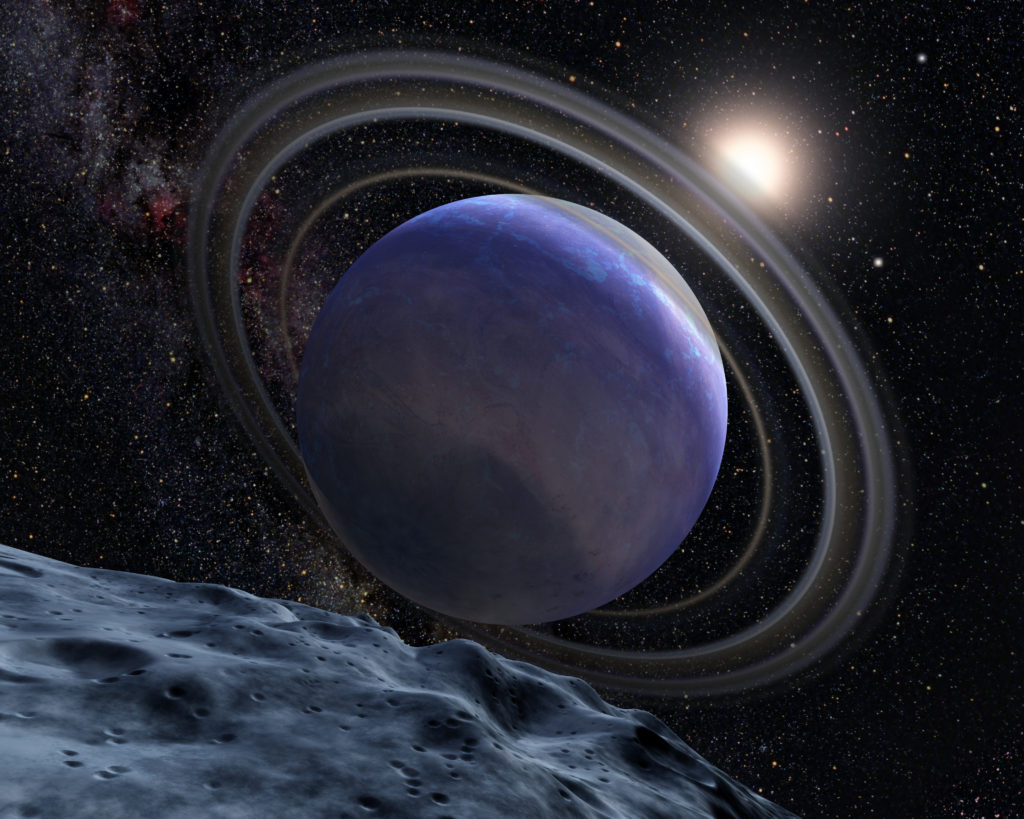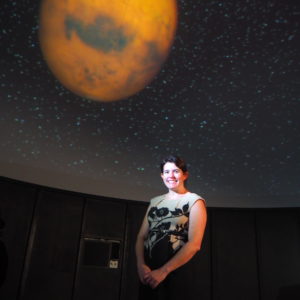Exoplanet Hunting: A Search for New Worlds
By Dr Catriona Nguyen-Robertson MRSV
This article revisits a presentation by Dr Jessie Christiansen at Melbourne Planetarium as part of the Inspiring Victoria Program and National Science Week 2018, and discusses where the search for exoplanets currently stands, five years on.

Eight planets (sorry Pluto) orbit our star, the Sun. But they are not the only planets out there. For years, people have wondered what exists beyond our solar system, and theorised the existence of exoplanets – planets orbiting others stars.
The first confirmation of a planet orbiting another sun-like star was in 1992. In the years since, more exoplanets have been found, and we subsequently entered the “exoplanet era”. First a trickle, then a flood. As at 2023, more than 5,000 planets beyond our solar system have been discovered.1
But it is not easy to find an exoplanet. With few exceptions, we cannot see them directly. Even with the largest, most powerful telescopes, they remain lost in the glare of their host stars. Instead, astronomers search for clues that reveal the presence of unseen worlds as detectives. NASA’s “Tomb Raider of exoplanet research”, Dr Jessie Christiansen, visited the Melbourne Planetarium during National Science Week 2018 to share her planet hunting missions.
Convincing the world of other worlds
In 600 BC, exoplanets were discussed as we would discuss the idea of alternative universes today. Perhaps they existed, perhaps they did not. But once Aristotle landed on the idea of Earth being unique, that was that, and all speculation was shut down. It was not until the Renaissance that the idea of planets beyond those around our star was revisited. Giordano Bruno claimed that there are ‘countless suns and countless Earths rotating around their suns in exactly the same way’, and that we only see their suns rather than the planets themselves. His teachings led him to be executed for blasphemy and heresy, his idea resoundingly rejected. Little did he (and everyone) know, he had been right. Isaac Newton also hypothesised that exoplanets exist, but had no means of confirming his hypothesis.
In the 20th century, ideas moved more rapidly. In 1952, astronomer Otto Struve claimed that we only know of our star and solar system, but that there are more beyond. Finally, in 1992, Alexander Wolszczan and Dale Frail published a paper in Nature announcing the discovery of the very first planets outside our solar system, rocky worlds around a dead star. Three years later, Michael Mayor and Didier Queloz observed a Jupiter-sized exoplanet (now termed a “hot Jupiter”) that orbits around its star. The idea that exoplanets exist had well and truly sunk in. Rather than being scorned, Mayor and Queloz were celebrated for their discovery, and were awarded the 2019 Nobel Prize in Physics.
The great exoplanet census

Jessie’s hunt for exoplanets began with NASA’s Kepler Mission. A one-metre telescope was sent into space in a vessel the size of a school bus to search for Earth-like planets (i.e., rocky planets containing water) orbiting a Sun-like star. At the time of Jessie’s presentation in 2018, the total number of known exoplanets was 3,264, with more than two-thirds having been found by this one telescope alone.
The Kepler telescope used the transit method to detect exoplanets: catching planets as they orbited around a star. When the exoplanet would “transit” across the view of the telescope, it would briefly block a patch of light coming from that star (like seeing a black spot on the sun in the sky). Kepler looked in one direction and focused on 200,000 stars, providing enough data to find thousands of planets. It was then the job of people back on Earth, such as Jessie, to sift through this data to detect them. This method provides information on an exoplanet’s size and mass (from which density can be derived), and its atmospheric properties. But it also leads to many false positives, as sunspots and other anomalies can appear as transiting exoplanets.
This made it difficult to detect small, Earth-like planets. However, Hot Jupiters were found in abundance, as they block more light and are hence easier to detect. Furthermore, many of the planets that were discovered frequently blocked light, meaning that they orbit closer to their star than Earth does, with each revolution much shorter than 365 days.
The Kepler telescope detected thousands of planets from a small patch of sky – the size of your hand as you look up at it. Imagine if the area we searched were to be extended…
Finding exoplanets with TESS
Knowing that planets that orbit close to their star are common, NASA produced the Transiting Exoplanet Survey Satellite (TESS) to specifically search for them, especially those that are Neptune-sized and smaller.2 TESS comprises four 10cm cameras, and while this is greatly scaled down from Kepler, the cameras are more targeted, as NASA now knows what to look for.
TESS was designed to scan the southern hemisphere skies for one year, followed by the northern hemisphere, shifting each month to look outwards in each patch of sky, eventually covering the skies of the entire globe. At each patch it points towards, Jessie will look for at least three transits across the star to consider a spot as a planet – therefore meaning that its orbit must be within ten days if it is to pass across three times within a month.
TESS was launched on a SpaceX Falcon 9 rocket in April 2018, and Dr Christiansen was at the launch to cheer it on. As she was delivering her presentation in the Planetarium on 13 August, it was Monday morning in California, where her colleagues had just been beginning to examine the data that had started to download a few days prior.
As its primary mission, TESS imaged about 75% of the starry sky – and it is still going. Within its two-year survey, TESS found 66 new exoplanets as well as nearly 2,100 additional candidates that astronomers are working to confirm. Now, around five and a half years since its launch, it is remains active and has found 392 confirmed exoplanets and nearly 7,000 candidates.3 Jessie believes that it could last a further 20-30 years, during which time it could keep searching for smaller, Earth-like exoplanets or exoplanets further away from their star that may transit (i.e., complete an orbit) less frequently. TESS is finding exoplanets ranging from small, rocky worlds to giant planets, showcasing the diversity of planets in our galaxy.
How long can our search for planets last? NASA predicts TESS will find 16,000 planets, jumping from 70 known exoplanets, to over 3,000 after Kepler, to 16,000 with TESS. NASA is also currently developing a 2.4m infrared telescope as part of the Nancy Grace Roman Space Telescope that will be launched in 2025 or 2026 to search for cold planets, which is predicted to find 100,000 planets. So far, it seems as though the numbers are only going up and up.
Importantly, you do not need to be a professional astronomer to find new worlds orbiting distant stars. We can all be a part of the mission to hunt for exoplanets. Jessie invites everyone to participate in the search as citizen scientists.
Although we can build stunning telescopes that produce vast amounts of valuable data, we can’t yet build an algorithm that approaches the extraordinary abilities of the human brain to examine that data. It is easier to train people to find planets from the mission data than it is a computer, and therefore NASA has created citizen science projects (exoplanetexplorers.org) for people to search for themselves – and it so far has saved her years of work. You may even discover a planet yourself!
References:
1. NASA Exoplanet Science Institute. (2019). “NASA Exoplanet Archive” exoplanetarchive.ipac.caltech.edu (Accessed 2023, October 10)
2. Barclay, T. (2023, September 21). NASA – TESS Science Support Center. TESS. tess.gsfc.nasa.gov
3. Exoplanet Exploration Program and the Jet Propulsion Laboratory. (Updated 2021, March 22). “Transiting Exoplanets Survey Satellite (TESS) – Exoplanet Exploration: Planets Beyond Our Solar System”. exoplanets.nasa.gov/tess (Accessed 2023, October)






